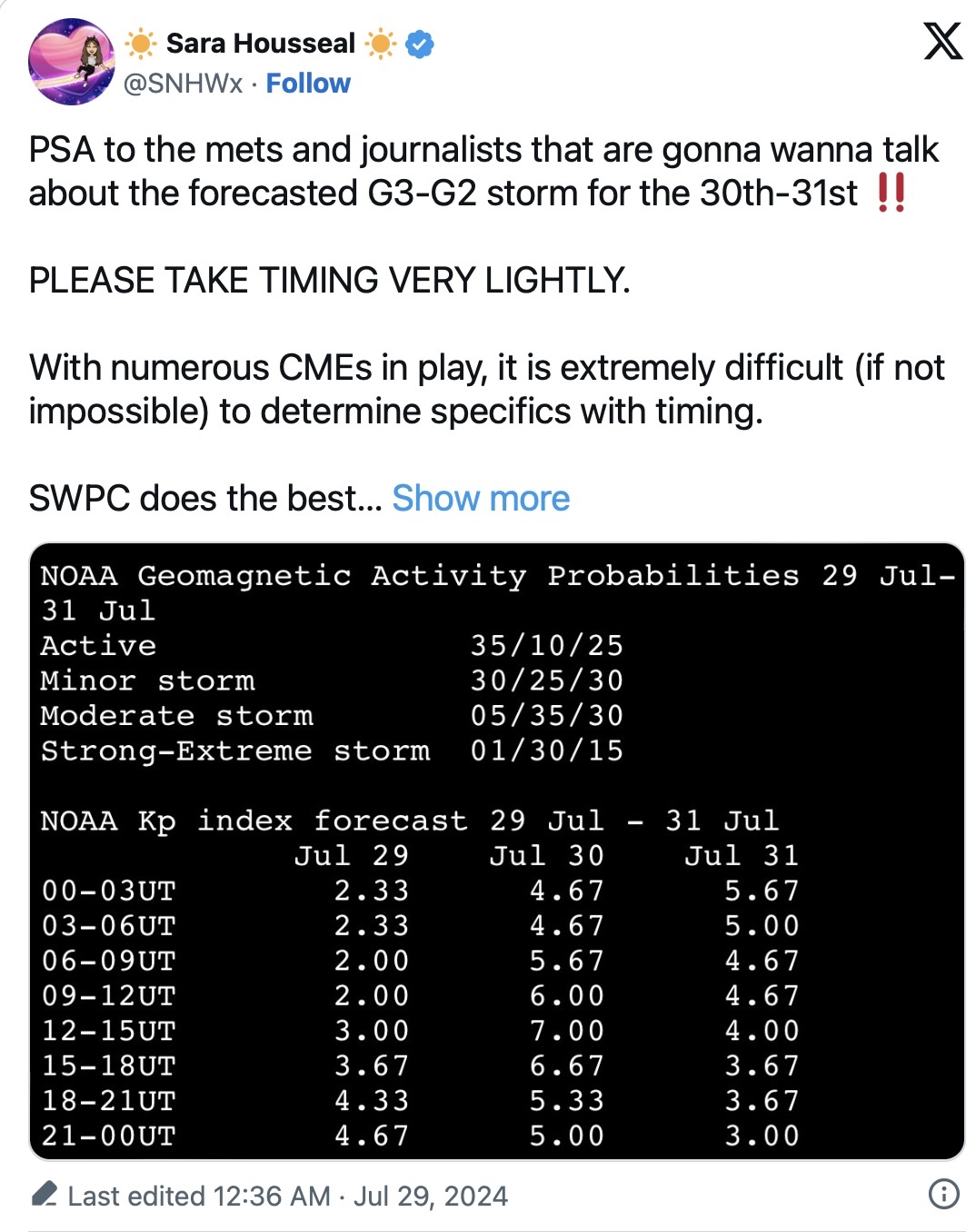30.07.2024
Geomagnetic storm conditions are predicted for July 30 through Aug.1.
Strong solar activity has prompted the National Oceanic and Atmospheric (NOAA) Space Weather Prediction Center (SWPC) to issue a geomagnetic storm warning for July 30 through Aug. 1.
If the predicted G3 conditions are reached, auroras could be visible across mid-latitudes around 50°. Previous geomagnetic storms at this magnitude have triggered auroras as low as Illinois and Oregon, according to NOAA SPWC.
The first of several incoming coronal mass ejections (CMEs) struck Earth's magnetic field on July 29 at 8:27 p.m. EDT (0027 on July 30), sparking a minor geomagnetic storm.
"This is an auspicious start to the multiple storm train we are expecting over the next few days," space weather physicist Tamitha Skov wrote in a post on X in response to a post from NWS Riverton about auroras spotted as far south as Wyoming, U.S. during the solar storm.
The culprit? A series of powerful M-class solar flares released from the sun over the weekend were accompanied by several plumes of plasma and magnetic field known as coronal mass ejections (CMEs). And Earth is in the firing line.
The first two CMEs released merged and formed what is known as a "cannibal CME" which is effectively clearing a path for at least two additional CMEs that are trailing behind it, according to Spaceweather.com. The arrival window for the CMEs is predicted for July 30 through to early Aug. 1, but there is a level of uncertainty about the exact timings.
CMEs carry electrically charged atoms called ions. When CMEs collide with Earth's magnetosphere, they can trigger geomagnetic storms. During these storms, the ions interact with gases in Earth's atmosphere, releasing energy as light. This phenomenon is known as the northern lights, or aurora borealis, in the Northern Hemisphere, and the southern lights, or aurora australis, in the Southern Hemisphere.
Geomagnetic storms are classified by NOAA using a G-scale to measure the intensity of geomagnetic storms. They range from G5, the most extreme class to G1 minor class storms. The recent geomagnetic storm watch issued by NOAA is currently classified as a G3-class for July 30, with G2 periods expected on July 31.
When will the geomagnetic storm occur?
Current forecasts predict G3 geomagnetic storm conditions may arrive on July 30, though the exact timings are uncertain. Minor G1 conditions were reached when an early CME hit Earth's magnetic field on July 29 at 8:27 p.m. EDT (0027 on July 30).
Similar to Earth's weather, space weather is unpredictable and challenging to forecast. While geomagnetic storm warnings of this level are uncommon, they can still sometimes fizzle to nothing.
Sara Housseal, a space weather forecaster, took to X to convey the importance of taking any timings very lightly.
"With numerous CMEs in play, it is extremely difficult (if not impossible) to determine specifics with timing," Housseal wrote.

As we approach July 30, space weather forecasters will better understand whether and when to expect the CME's arrival.
If you want to keep a watchful eye on the space weather conditions and know when (and where) to look out for auroras, I recommend downloading a space weather app that will let you know the predicted conditions based on your location. I use an app called "My Aurora Forecast & Alerts" available on iOS and Android. But any similar app should do the job. I then couple this with the Space Weather Live app available on iOS and Android. This app is great as it gives you more of an insight into whether the space weather conditions are looking promising for aurora activity.
How could this event compare to May's auroras?
If you want to keep a watchful eye on the space weather conditions and know when (and where) to look out for auroras, I recommend downloading a space weather app that will let you know the predicted conditions based on your location. I use an app called "My Aurora Forecast & Alerts" available on iOS and Android. But any similar app should do the job. I then couple this with the Space Weather Live app available on iOS and Android. This app is great as it gives you more of an insight into whether the space weather conditions are looking promising for aurora activity.
Quelle: SC
